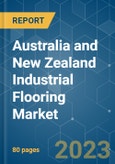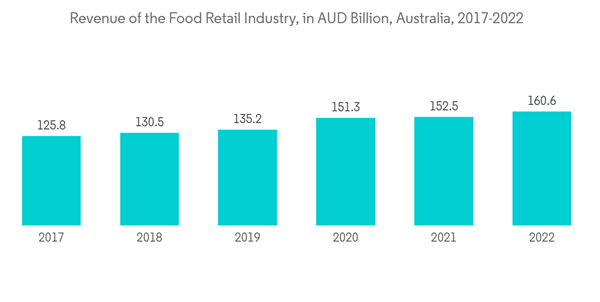Key Highlights
- COVID-19 negatively impacted the market in 2020. The building and construction industry came to a standstill owing to the unavailability of raw materials, shortage of laborers, and disruption in the supply chain. However, the market reached pre-pandemic levels in 2022 and is expected to grow steadily in the future. The upsurge in demand for industrial flooring in the food and beverage industry has propelled market growth.
- Over the medium term, the growth of the industrial flooring market is likely driven by the growing awareness about the advantages of industrial flooring. Industrial floorings, which have gradually changed from conventional cement flooring tiles to dust-free monolithic floors, play a vital role in productivity, safety, and housekeeping.
- There are different types of industrial flooring, including polyurethane (PU) flooring, polyethylene (PE) foam flooring, and epoxy flooring. They provide excellent pavements in strength, thickness, flexibility, washability, aesthetics, resistance to toxic and corrosive chemicals, mechanical abrasion, static, and microbial outgrowth, among many other factors.
- Fluctuating raw materials and high product prices will likely hamper the industrial flooring market growth. The emerging application of industrial flooring in the healthcare industry is expected to offer new opportunities for overall industry growth.
Australia and New Zealand Industrial Flooring Market Trends
Epoxy Flooring to Drive the Market Growth
- Epoxy is a material that serves as a sealant for concrete floors. It creates a shiny gloss surface and increases the brightness of the coated area by up to 200%. Epoxy is made up of two components resins and hardeners. The chemical reaction caused by mixing these components leads to the production of a rigid plastic material. This plastic material exhibits several properties, such as high strength, degradation resistance, and strong substrate bonding ability.
- This epoxy can be used as a thick flooring material over a concrete subfloor or can be used to provide a protective layer on the substrate. If the thickness of epoxy material, which is applied to the floor, is more than 2 mm, it is called an epoxy floor. However, if the thickness of epoxy remains less than 2 mm, it is referred to as epoxy floor coating. The service life of epoxy coatings is expected to be about 20 years or more.
- The application of epoxy flooring offers various benefits. For instance, when applied on the surface, it provides excellent heat, spillage, slippage, abrasion, and chemical resistance. It can provide adhesion to cement, metal, or wood surface. The surface applied with epoxy remains antistatic and seamless and is easier to clean and maintain.
- Water-based or dispersed epoxy resin floor materials do not contain harmful solvents or VOCs (volatile organic compounds); therefore, they can be used safely in occupied areas. Additionally, these resins are not sensitive to naked flames, and more importantly, when used in the food and beverage industry, these resins do not contaminate foodstuffs or beverages.
- Solvent-free epoxy resin flooring products have much higher epoxy resin contents, and they are also used in much thicker layers and thus provide higher performance and protection for the floor. These resins are mostly used in factory processes and production areas with increased traffic, abrasion, or liquid chemical exposure.
- Owing to such properties, epoxy resins are used extensively in industrial areas, commercial buildings, and public places, including shopping malls, garages, institutions, hospitals, schools, industrial buildings, prisons, and sports halls. However, in recent times, the usage of epoxy coatings can also be seen in residential applications.
- As of September 2022, approximately NZD 7.8 billion (USD 4.88 billion) worth of non-residential building work across New Zealand was completed, an increase from 2017 (NZD 7.4 billion (USD 4.63 billion worth of non-residential building work). In New Zealand, the value of non-residential building activity was 18 percent higher in the year ended September 2022 than in September 2021.
- In December 2022, private sector dwellings excluding houses approved rose 56.6% in Australia, while private sector houses fell 2.3%. In seasonally adjusted terms, the total number of dwelling units in Australia fell by 5.2% to 45,489 dwellings in the September quarter.
- Hence, owing to the ongoing construction activities in the region, the demand for epoxy resins in the industrial flooring market is expected to increase during the forecast period.
Food and Beverage Segment to Dominate the Market
- In the food and beverage industry, industrial flooring is vital as these spaces must be spill-free, meet the highest hygienic standards, and withstand extreme thermal, mechanical, and chemical impacts.
- The food and beverage industry uses a combination of chemical resistance, durability, and antistatic features comprising flooring representing a safe working environment. The antistatic properties of the flooring system protect electrostatic-sensitive devices and can be used in explosion-hazard areas.
- The Global Food Safety Initiative (GFSI), the Food Standards Agency (FSA), and the European Food Safety Authority (EFSA) issued stipulations to ensure food factories maintain the highest standards of handling and production. Many of the flooring used in this industry help maintain non-slip resin nature, and they are antimicrobial and comply with strict hygiene and safety standards.
- The food and beverage industry flooring is designed in a way that is resistant to steam and hot water wash-downs, resistant to cleaning chemicals, and impervious to animal fats, even under heavy-use conditions. This application of industrial flooring reduces maintenance costs due to sticky stains and others in the industry.
- In 2022, the annual revenue of the retail food industry in Australia amounted to over AUD 160 billion (USD 118.28 billion). Additionally, the demand for plant-based food is increasing rapidly in Australia. Australian food & beverages value-added output grew by 1.1% in 2021. It’s predicted that by 2030 the Australian plant-based sector will contribute almost AUD 3 billion (USD 2.22 billion) in domestic sales.
- According to the International Wines and Spirits Record (IWSR), the no- and low-alcohol beverages market has reached USD 10 billion and is set to grow by 8% by 2025. This is compared to only a 0.7% growth of regular alcohol volume during the same period.
- The production of food products is increasing in New Zealand owing to the increased exports. New Zealand is a major food and beverage exporter, accounting for 46% of all goods and services exports.
- These aforementioned factors are expected to boost the adoption of industrial flooring in the food and beverage industry.
Australia and New Zealand Industrial Flooring Industry Overview
The industrial flooring market in Australia & New Zealand is fragmented in nature. The major players in the market include Antiskid Industries, Multiblast Flooring Pty Ltd., Roxset Australia, Sika Australia, and Bethell Flooring, among others.Additional Benefits:
- The market estimate (ME) sheet in Excel format
- 3 months of analyst support
This product will be delivered within 2 business days.
Table of Contents
1 INTRODUCTION1.1 Study Assumptions
1.2 Scope of the Study
2 RESEARCH METHODOLOGY
3 EXECUTIVE SUMMARY
4 MARKET DYNAMICS
4.1 Drivers
4.1.1 Increasing Demand from the Food and Beverage Industry
4.1.2 Growing Application in Chemical Industry
4.2 Restraints
4.2.1 Fluctuating Prices of Raw Material
4.2.2 High Product Prices
4.3 Industry Value Chain Analysis
4.4 Porter's Five Forces Analysis
4.4.1 Bargaining Power of Suppliers
4.4.2 Bargaining Power of Consumers
4.4.3 Threat of New Entrants
4.4.4 Threat of Substitute Products and Services
4.4.5 Degree of Competition
5 MARKET SEGMENTATION (Market Size in Value)
5.1 Resin Type
5.1.1 Epoxy
5.1.2 Polyaspartic
5.1.3 Polyurethane
5.1.4 Acrylic
5.1.5 Other Resin Types
5.2 Application
5.2.1 Concrete
5.2.2 Wood
5.2.3 Other Applications
5.3 End-User Industry
5.3.1 Food and Beverage
5.3.2 Chemical
5.3.3 Transportation and Aviation
5.3.4 Healthcare
5.3.5 Other End-User Industries
6 COMPETITIVE LANDSCAPE
6.1 Mergers and Acquisitions, Joint Ventures, Collaborations, and Agreements
6.2 Market Share (%)**/Ranking Analysis
6.3 Strategies Adopted by Leading Players
6.4 Company Profiles
6.4.1 ANTISKID INDUSTRIES
6.4.2 Bethell Flooring
6.4.3 Elite Crete Systems
6.4.4 Hychem International Pty Ltd (VIACOR)
6.4.5 Interface Inc.
6.4.6 LATICRETE Pty Ltd
6.4.7 Mapei Australia Pty. Ltd
6.4.8 MBCC Group
6.4.9 Multiblast Flooring Pty Ltd.
6.4.10 RPM International Inc.
6.4.11 Roxset Australia
6.4.12 Sika Australia
6.4.13 Twintec Group Limited
7 MARKET OPPORTUNITIES AND FUTURE TRENDS
7.1 Emerging Applications in Healthcare Sector
Companies Mentioned (Partial List)
A selection of companies mentioned in this report includes, but is not limited to:
- ANTISKID INDUSTRIES
- Bethell Flooring
- Elite Crete Systems
- Hychem International Pty Ltd (VIACOR)
- Interface Inc.
- LATICRETE Pty Ltd
- Mapei Australia Pty. Ltd
- MBCC Group
- Multiblast Flooring Pty Ltd.
- RPM International Inc.
- Roxset Australia
- Sika Australia
- Twintec Group Limited










